- Home
- Organic Form in Art Inspired by Nature
Organic Form in Art -
Inspired by Nature
Organic form in art? And inspired by nature too? Oh my! Why would we ever be stuck for ideas? There's so much beautiful, exciting stuff out there waiting for us to discover!
I've found some contemporary artists (with the exception of M.C.Escher) who have done just that - let's take a look at how each one sees their world...
(links to artists' websites at bottom of page)
Trees and Leaf Forms
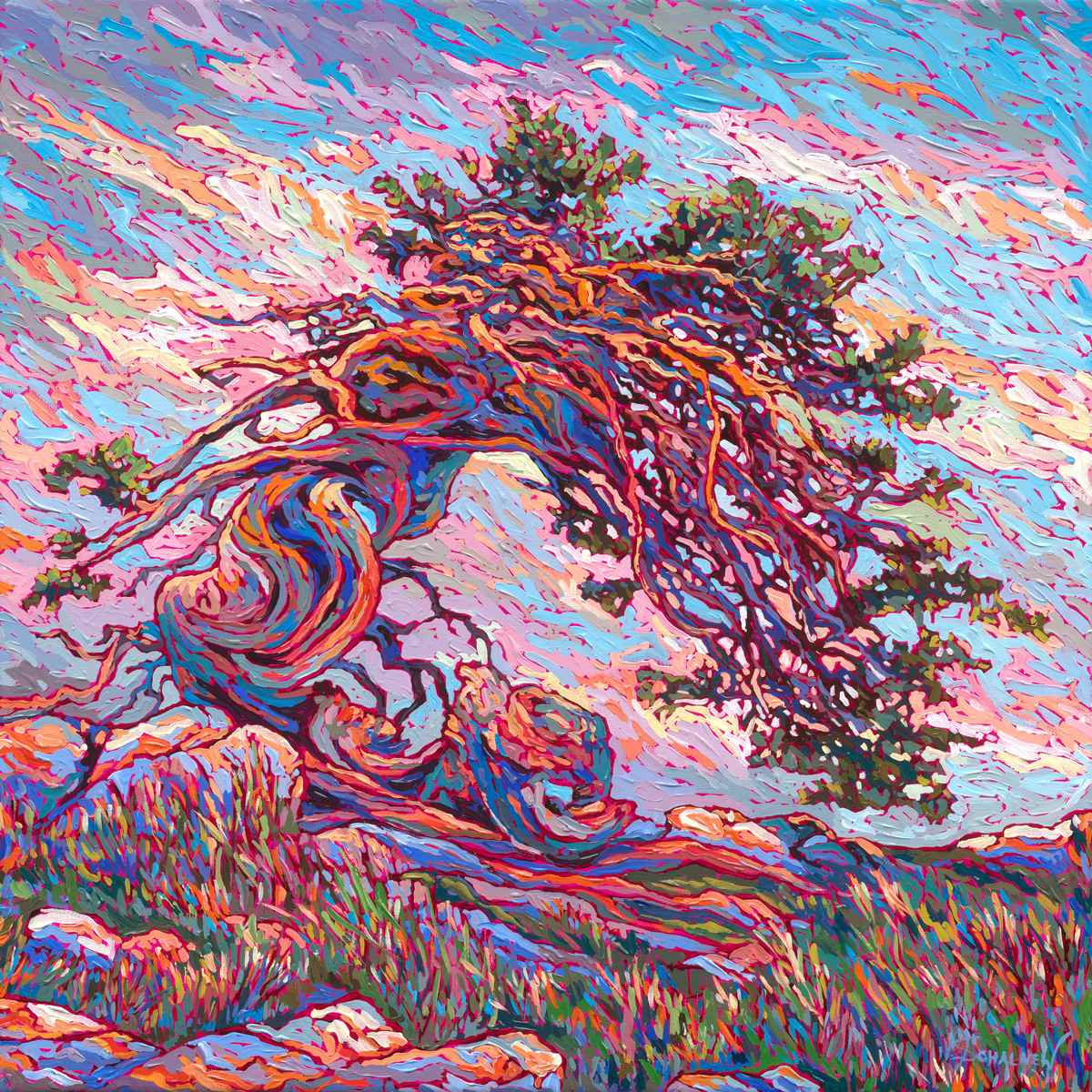 ©"Old Tree", Acrylic on Canvas, by Viktoria Schalnew
©"Old Tree", Acrylic on Canvas, by Viktoria SchalnewWow! Viktoria isn't holding back, is she? What energy she has expressed in the form of this writhing tree, that has battled wind and weather since it was a sapling! And her chosen colors? Nothing soft and gentle here - but strong, dramatic colors to convey just what she feels about her subject.
Remember, in your work, you're the boss! If, like Viktoria, you love bright colors, there's no rule to say you have to paint a tree brown, is there? Okay, there might be occasions where browns or silvery greys express exactly what you want, but it's your work, you're in charge and you totally have the choice. Fun, yes?!
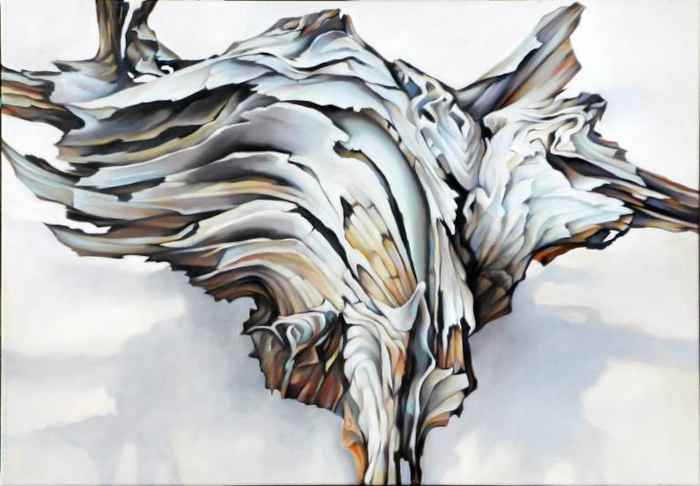 ©"Driftwood", Oil on Canvas, by Maggy Kukler
©"Driftwood", Oil on Canvas, by Maggy KuklerOn the other hand, Maggy Kukler is an artist who absolutely revels in the soft ochres, browns and silvery greys of an ancient tree - but this time in the interesting form of driftwood washed up by the sea.
This detailed close-up painting takes on an abstract feel as Maggy enjoys exploring each peeling flake of wood, bringing out the driftwood's overlooked beauty.
Maybe we wouldn't have even noticed it as we scuffed along the shore, but it takes an artist with a very perceptive eye to pounce on it and turn it into beautiful art!
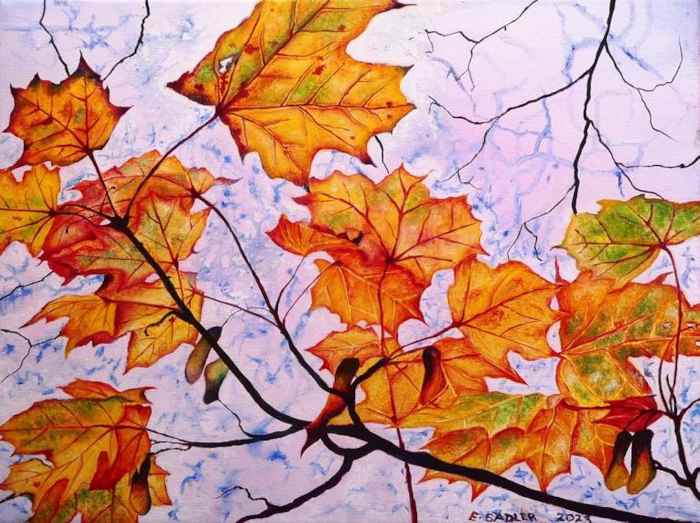 ©"Autumn's Gold", Oil on Canvas, by Elizabeth Sadler
©"Autumn's Gold", Oil on Canvas, by Elizabeth SadlerHere we have a lovely study of Autumn leaves. Elizabeth is obviously enjoying the flat pattern the leaves make against the sky, even though we see, in some places, the leaves curling into three-dimensional forms.
By the way, have you spotted another reason why this painting is so eye-catching? It's Elizabeth's clever use of complementary colors. The blue/mauve background is the perfect choice to really show up those orange and gold leaves!
 ©"Walnut Tree", Acrylic on Wood, by Denys Golden
©"Walnut Tree", Acrylic on Wood, by Denys GoldenDenys Golden has taken the pattern of leaf forms a bit further into abstraction. We see how he's flattened the forms into silhouettes, making a satisfying arrangement for this semi-abstract work.
All done in shades and tones of green - you can imagine the soothing effect it would have in a room.
I like the way the circular walnuts contrast with the leaf shapes, don't you? They add important visual interest, making the different pattern of leaves look even more delightful!
Next time you're near trees, take a close look at the leaves - there are so many different shapes to choose from. Make a quick sketch or take a photo for inspiration. You'll be glad you did when you get back to your art space and feel stuck for something to paint!
Fruit and Flower Forms
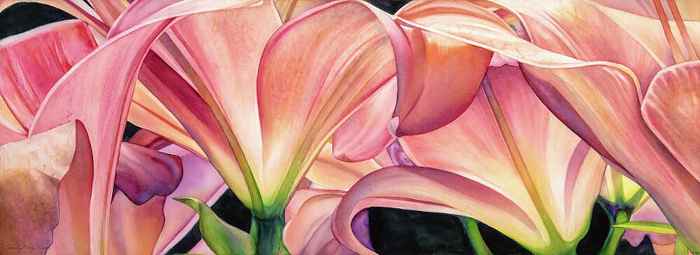 ©"Canopy" Watercolor, by Sandy Haight
©"Canopy" Watercolor, by Sandy HaightHere's what happens if you zoom close into a flower's world! In this watercolor Sandy skilfully portrays the arching forms of the flowers, and calls it "Canopy". It reminds me of those huge, arched and carved ceilings of Gothic cathedrals.
We know an arch makes for a strong construction in wood or stone - and it's no accident that nature uses it too in its creation of these beautiful flowers.
Surprise yourself! When you next choose some flowers for your home, take a moment and look closely at their forms. Capture a bee's-eye view with your camera. It could be the start of a whole new series of paintings!
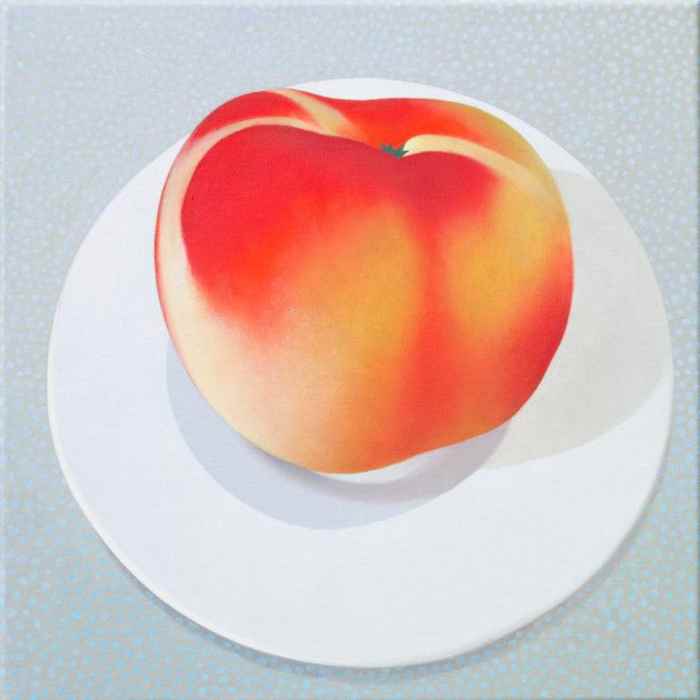 ©"Nectarine. Plate", Oil on Canvas, by Robert McPartland
©"Nectarine. Plate", Oil on Canvas, by Robert McPartlandOne fruit. One plate. One background. It says it all! The perfect nectarine, beautifully colored, on a pristine white, circular plate; very faint patterning in the background for subtle contrast - and that's it!
Robert has deliberately chosen a very simple format here to convey the visual impact of his perfect nectarine.
Mind you, don't be deceived by the simplicity of this painting - it's been very carefully worked out. For instance, notice the way the fruit is just slightly overlapping the plate in one area? This makes us aware of it's 3-dimensional form - of its weight as it sits on the plate. Not accidental, that.
And I love the way the simple, curved markings on the nectarine describe its form too - just those, and we know exactly what it would feel like to hold it and take a juicy bite!
If you haven't thought about trying a still life before, why not give it a go? Pick just three elements including background, and you're off!
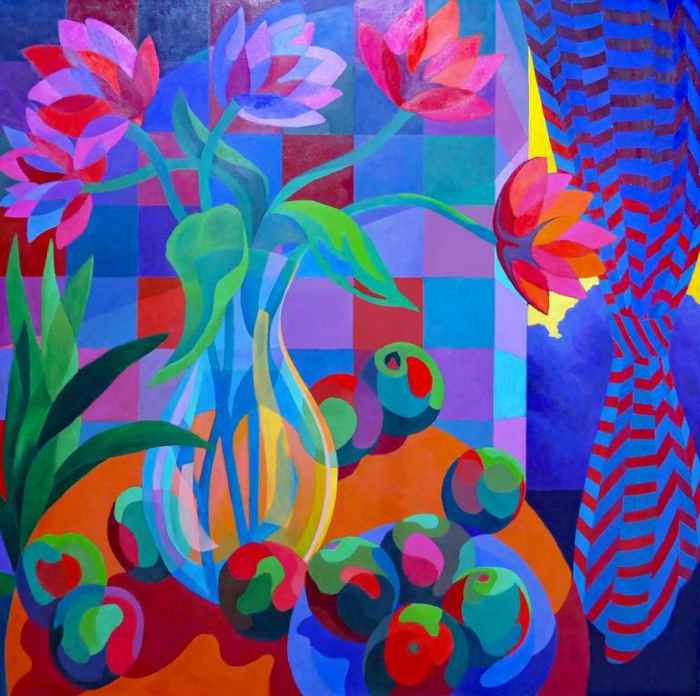 ©"Still life With Five Flowers", Acrylic on Canvas, by Stephen Conroy
©"Still life With Five Flowers", Acrylic on Canvas, by Stephen ConroyOrganic form in art doesn't get more exuberant than this! Obviously, Stephen really enjoyed painting the flowing forms in this vibrant still life.
It's all about contrasts - contrasts of color as well as contrasts of form.
Notice how he places all the curving forms against a squared, angular background? Those squares (and the zig-zag pattern on the curtain) really show off the organic shapes in front of them.
And if you're in exuberant mood like Stephen and want to try something like this, check out his color choices! All the complementary color combinations are at play here in one painting - red/green; blue/orange; yellow/purple!
Sea Shell Forms
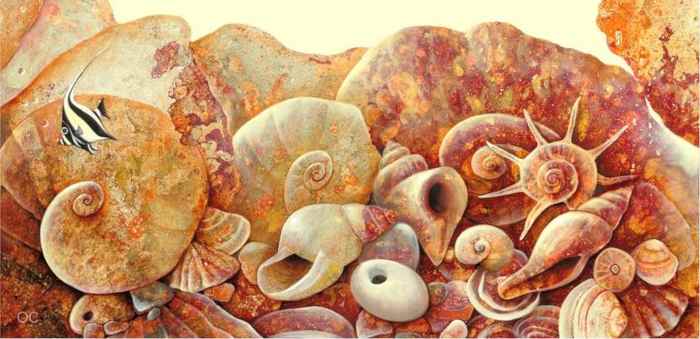 ©"Red Reef Fossils", Oil on Canvas, by Olga Suslova
©"Red Reef Fossils", Oil on Canvas, by Olga SuslovaHere is a beautifully observed still life by Olga Suslova.
She says, "What I try to express through my painting is a sense of harmony in nature, the magic that is hidden even in the smallest things."
We can see her passion for marine life in the careful, I could even say, loving way she has painted these miraculous natural forms.
And the fish! What a great idea - placing the black and white, living creature as a contrast amongst the jumble of ochre and red fossils and empty shells! Perfect!
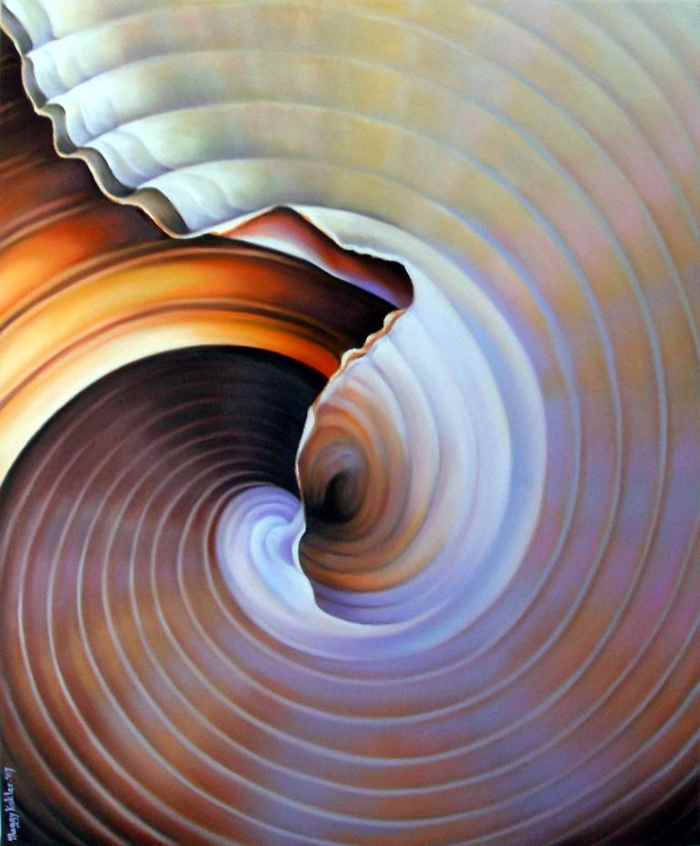 ©"Whirl iii", Oil on Canvas, by Maggy Kukler
©"Whirl iii", Oil on Canvas, by Maggy KuklerHere's another very closely observed work by Maggy Kukler. It's big - 50x60cm (about 21x24 inches), making us feel as if we're right inside the spiraling form of a long-departed shell-fish's home.
And what an amazing form, it is! Maggy shows us again (as in her driftwood painting above) how we can find beauty in an often overlooked natural form and turn it into abstract art.
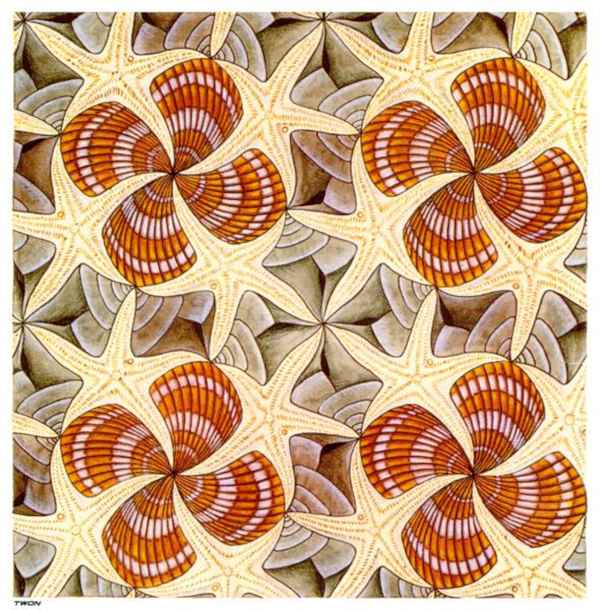 "Shells and Starfish" by M.C.Escher 1941
"Shells and Starfish" by M.C.Escher 1941Didn't Escher love to confuse us with his intricate images?! Here's one with a slightly op-art effect. Sometimes we see starfish - sometimes we see shells!
(Oh! I just found another kind of shell I missed!)
Liquid Forms
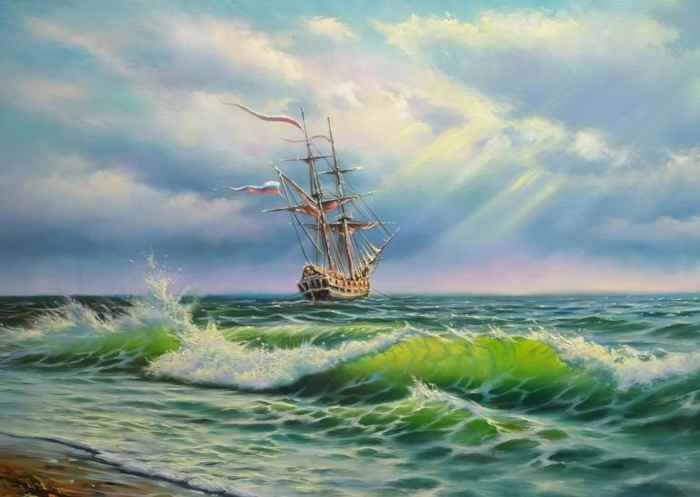 ©"Oceanic Journey Awaits", Oil on Canvas, by Sultan Aubekerov
©"Oceanic Journey Awaits", Oil on Canvas, by Sultan AubekerovHave you ever stood on a beach and been mesmerised by the curving wave forms, everlastingly always the same, but always different, that roll in, break and recede; roll in, break and recede...?
And have you seen that magical green light that sometimes shines through the breaking waves? Sultan has captured it exactly, hasn't he?
He's certainly done a great job here - and given us, too, a breath of salty air and the sound of waves breaking on the shore as the ship sails away on her adventure.
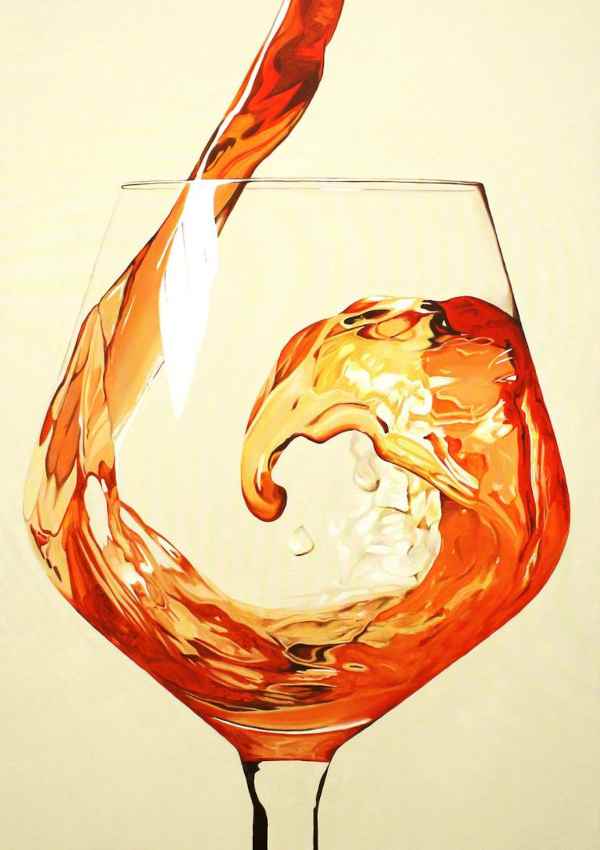 ©"Ebrezza Degli Aromi", Oil on Canvas, By Lucia Bergamini
©"Ebrezza Degli Aromi", Oil on Canvas, By Lucia BergaminiThis is interesting because the same wave formation is happening here as in the previous work, but this time in miniature! Amazing - whether it's vast ocean, or liquid in a wine glass, natural laws will always find their way!
Lucia's passion is hyper-realism and she has captured perfectly in paint that split second moment in time, as the liquid hits the side of the glass, surges round and up, into a curving wave form.
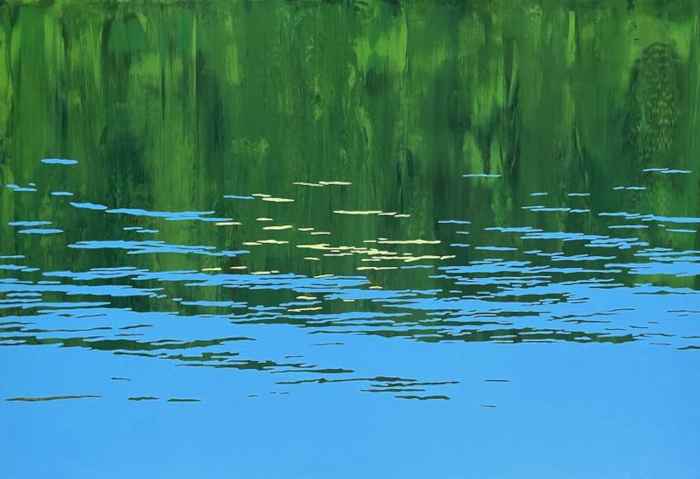 ©"Whisper 30.06", Acrylic on Canvas, by Tomek Mistak
©"Whisper 30.06", Acrylic on Canvas, by Tomek MistakTomek has a different way of expressing liquid form. In this painting the water is almost still but not quite, as we see the tiny rippling forms on the quiet surface.
He has pared the painting down to it's essentials - the dragged green brushstrokes of the reflected trees describe deep water. Then crisp, precise marks done with a small brush are all that's needed for the water's surface.
Works well, yes?
Snow and Ice Forms
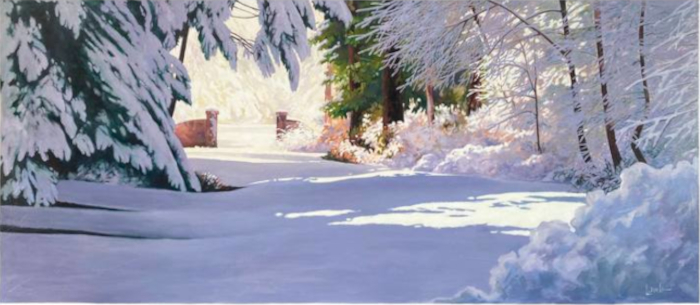 ©"On Earth as it is in Heaven", Acrylic on Canvas, by Sandra Lamb
©"On Earth as it is in Heaven", Acrylic on Canvas, by Sandra LambSnow - that white stuff that looks so magical when it first comes down!
It doesn't seem to have much form at all when we see it feathering through the air - but if there's enough of it, as we see here, it soon piles up, transforming everything it touches into soft, undulating forms.
But there is sunshine in this view too, so Sandra has painted in the beautiful blue shadows that we see on snowy days, which do so much to emphasise the snow's rounded forms.
She says she's glad of a camera where she lives, to use " ...on those rare three or four days when Eden touches Earth".
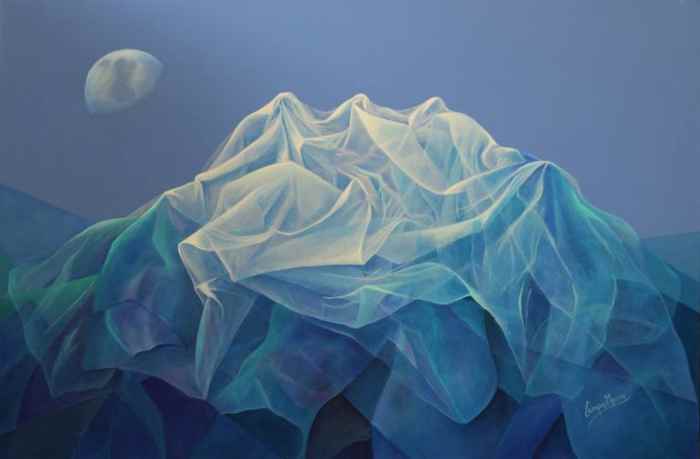 ©De Nieve y Viento (Snow and Wind)", Acrylic on Canvas, by Cecilia Campos
©De Nieve y Viento (Snow and Wind)", Acrylic on Canvas, by Cecilia CamposStuck indoors because of the weather? Who cares? Create a cold, snowy landscape right there on your art table!
Cecilia, with her artist's eye, has chosen a light, filmy fabric to convey her idea of wind blowing across a snowy mountain. To emphasise the wintry, outdoors feel she pops a moon in the sky and paints the whole work in cold blues and turquoise.
Great idea! (Brrr! Where's my jumper?)
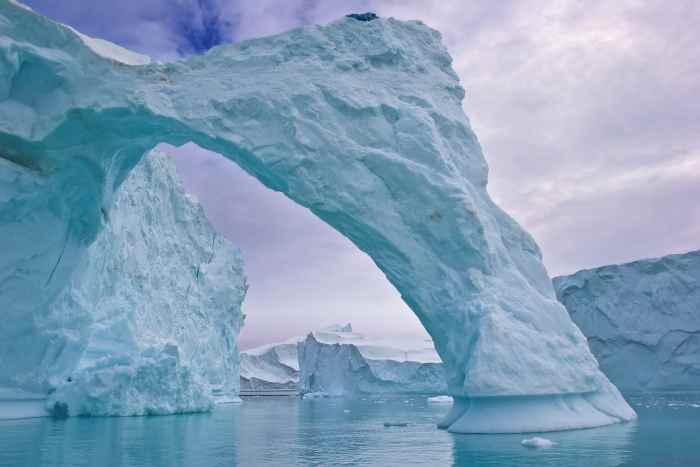 Photo of Ice Arch Carved by the Wind in Giant Iceberg.
Photo of Ice Arch Carved by the Wind in Giant Iceberg.
Nature Inspired, Organic Form in Art - Your Way!
We've only explored five categories of nature-inspired organic form in art here, but the fourteen artists, above, all approach it in different ways.
Which painting resonates with you the most? Use it as a jumping off point - your work will be different because there's nobody exactly like you with your unique way of looking at the world!
So show us what you find beautiful, peaceful, dramatic, exciting, astonishing or whatever it is that moves you to say - "Hey, look at this amazing thing I've noticed about this form!"
Get inspired by nature; take a walk outside - beach, woods, park, maybe even in the city street. Or stay inside and explore your kitchen!
Of course, there are more organic forms we haven't dealt with on this page. Here are a few I've just thought of. Can you add to the list?
- Bubbles
- Planets
- Rocks
- Mountains
- Pebbles
- Clouds
- Wild-life
- Pets
- Faces
- Sparkling, dew-drenched spider's webs
- Frosted Winter seed-heads
- Seaweed
- Eggs
- Acorns
- Glossy horse-chestnuts in their prickly outer cases
- Autumn berries
- Breakfast
- Wind blowing newspapers in the street into fantastic abstract shapes
Take a camera or sketch-pad with you on your walks for quick notes to remind you what you saw and liked.
Just think, whether you're into landscape, still-life, realism, abstract or imaginative, if you keep your artist's eyes open for nature's fabulous forms, you need never be stuck for ideas again!
Good luck!
Viktoria's Schalnew's website: schalnew.com
Maggy Kukler's website: maggy.kukler.com
Elizabeth Sadler can be found at saatchart.com
Denys Golden's website: goldengallery.ca
Sandy Haight's website: sandyhaightfineart.com
Robert McPartland's website: robertmcpartland.com
Olga Suslova's website: olgasoo.com
Lucia Bergamini's website: luciabergamini.com
Tomek Mistak's website: tomekmistak.com
Sandra Lamb's website: sandralamb.art
Cecilia Campos can be found at saatchiart.com
Like this page? Click the icons to share it.